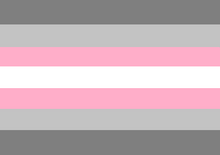No edit summary Tags: mobileedit sourceedit |
mNo edit summary Tag: Visual edit |
||
| (35 intermediate revisions by 19 users not shown) | |||
| Line 1: | Line 1: | ||
| − | [[File:Tumblr n176r6j6281r5b1yro1 500.png|thumb| |
+ | [[File:Tumblr n176r6j6281r5b1yro1 500.png|thumb|220px|Demigirl flag by transrants.<ref>http://transrants.tumblr.com/post/77071883543</ref>]] |
| − | A '''demigirl''' |
+ | A '''demigirl''' (also called a demiwoman, demilady or a demifemale person) is a [[gender identity]] describing someone who partially, but not fully, identifies as a [[woman]] or girl, whatever their [[assigned gender]] at birth. They may or may not identify as another gender in addition to feeling partially a girl or woman. |
| − | Demigirl can be used to describe someone [[AFAB|assigned female at birth]] who feels barely connected or disconnected to that identification, but does not experience a significant enough dissociation to create real physical discomfort or [[dysphoria]]. Demigirl can also describe someone [[AMAB|assigned male at birth]] who is [[transfeminine]] but not wholly [[Gender Binary|binary-identified]], so that they feel more strongly associated with |
+ | Demigirl can be used to describe someone [[AFAB|assigned female at birth]] who feels barely connected or disconnected to that identification, but usually does not experience a significant enough dissociation to create real physical discomfort or [[dysphoria]]. Demigirl can also describe someone [[AMAB|assigned male at birth]] who is [[transfeminine]] but not wholly [[Gender Binary|binary-identified]], so that they feel more strongly associated with "female" than "male," socially or physically, but not strongly enough to want to identify as a woman. Demigirls may also identify as [[demigender]], [[non-binary]] and/or [[transgender]]. |
| + | ==Flag== |
||
| − | Demigirls may also identify as [[demigender]], [[non-binary]] and/or [[transgender]]. The original coiner of the phrases demigirl and [[demiguy]] is unknown. |
||
| + | The white represents gender neutrality or a questioning and shifting of gender. |
||
| + | The pink represents the traditional color used for [[femininity]], which is associated with womanhood. |
||
| + | The shades of grey indicate the partial nature of the gender. |
||
| + | |||
| + | ==References== |
||
| + | <references /> |
||
[[Category:Beyond the Binary]] |
[[Category:Beyond the Binary]] |
||
[[Category:Nonbinary]] |
[[Category:Nonbinary]] |
||
Revision as of 16:50, 29 March 2021

Demigirl flag by transrants.[1]
A demigirl (also called a demiwoman, demilady or a demifemale person) is a gender identity describing someone who partially, but not fully, identifies as a woman or girl, whatever their assigned gender at birth. They may or may not identify as another gender in addition to feeling partially a girl or woman.
Demigirl can be used to describe someone assigned female at birth who feels barely connected or disconnected to that identification, but usually does not experience a significant enough dissociation to create real physical discomfort or dysphoria. Demigirl can also describe someone assigned male at birth who is transfeminine but not wholly binary-identified, so that they feel more strongly associated with "female" than "male," socially or physically, but not strongly enough to want to identify as a woman. Demigirls may also identify as demigender, non-binary and/or transgender.
Flag
The white represents gender neutrality or a questioning and shifting of gender. The pink represents the traditional color used for femininity, which is associated with womanhood. The shades of grey indicate the partial nature of the gender.